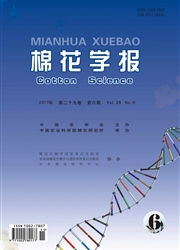

 中文摘要:
中文摘要:
以营养钵育苗移栽栽培方式作为生产对照(TO),于2004年在江苏省的东台、射阳分别对移栽地膜棉改进栽培方式(T1)和“工厂化育苗+无土移栽+地膜覆盖”栽培方式(T2)2种棉花栽培方式进行大田试验。结果表明:随着生育进程的推移,棉花单位面积干物质累积及氮素吸收量表现为T2〉T1〉TO,由于苗期受小麦的胁迫作用,射阳试点苗期的干物重和氮累积量均低于东台试点。方差分析表明,栽培方式对棉花衣分、产量、单位面积的铃数及各项纤维品质指标的影响达到显著水平,并以T2生产成本最低、产量最高,且纤维品质较优,其公顷铃数、皮棉产量较对照明显提高,分别为:东台36%和26%,射阳32%和28%;施氧量较对照减少38%。
 英文摘要:
英文摘要:
In order to study the effects of planting pattern ("Seedling nursing with nutrient bowl + transplant "model, TO; "Seedling nursing with nutrient bowl + transplant +mulch with plastic" model, T1; "Factory-cultivated seedlings + transplant without earth + mulch with plastic "model, T2), two field experiments were conducted in Dongtai and Sheyang in Jiangsu province, respectively. The result showed that, with the development of growth stage, the pattern of dry matter accumulation and nitrogen uptake per area could be expressed as T2〉 T1〉T0. The effects of planting pattern on dry matter and accumulation of nitrogen in root; nutrient organs and reproductive organs of cotton were also significants respectively. Among three planting patterns, the accumulation amounts of bio-mass and nitrogen with cropping pattern of T2 were the highest, which the nitrogen using efficiency was the highest,too. Due to the stress by plants of wheat in the seedling stage of cotton in Sheyang, the dry matter and nitrogen accumulation were lower than those of corresponding values in Dongtai. It was shown that the effects of planting pattern on lint percentage, yield, and number of boll per area were significantly. But the effects on boll number per plant and weight of boll was comparatively lower. The number of boll per area and lint yield with cropping pattern of T2 were 36% and 26% higher in Dongtai, and 32% and 28% higher in Sheyang than the corresponding curves with plantingpattern of T0,respectively. This result indicated that field managements of cotton should be focused on regulation and control of the lint percentage and boll number per area of cotton in practical field managements. By comparing the effects of planting pattern on the fiber quality such as strength, length, micronaire, uniformity, and elongation in two experimental sites, an extremely significant level was obtained, and fiber strength and micronaire were impacted more severely than other fiber properties. Fiber strength, micronaire, unif
 同期刊论文项目
同期刊论文项目
 同项目期刊论文
同项目期刊论文
 Cellulose increasing curve is highly relate to cotton fiber strength and is greatly determined by it
Cellulose increasing curve is highly relate to cotton fiber strength and is greatly determined by it 期刊信息
期刊信息
